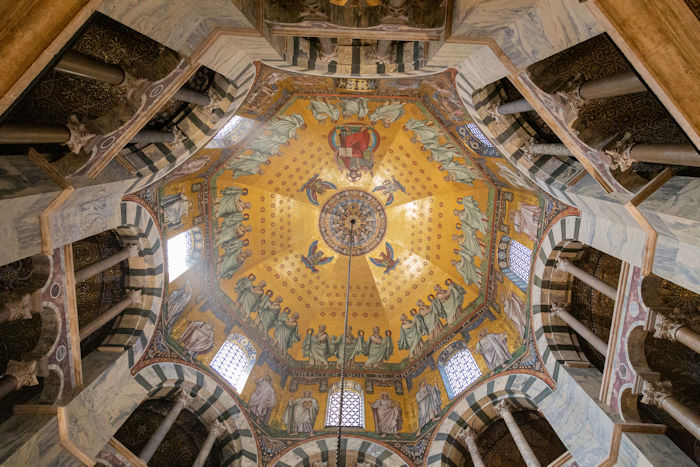Ellen Lloyd – AncientPages.com – According to a very controversial theory, our modern calendar is wrong because it misses 297 years. A German calendar skeptic claims he has found evidence supporting the hypothesis that our current calendar is based on a lie.
As previously discussed on AncientPages.com, “one of the most intriguing and highly controversial theories dealing with ancient history is, without doubt, the “Phantom Time Hypothesis“.

Emperor Otto III. Credit: Media Viewer – Public Domain
According to this unconventional and thought-provoking theory, the Early Middle Ages (614-911 A.D) never existed because the Western calendar was misdated.
The Phantom Time Hypothesis was developed by German scientist Heribert Illig. Another German researcher Hans-Ulrich Niemitz expanded on this theory after he accidentally learned about the problem of faked documents in the Middle Ages.” 1
By examining medieval texts and archaeological finds, Illig claims he has encountered incidents revealing we are missing 297 years!
The Phantom Time Hypothesis ᴀsserts that the Holy Roman Emperor Otto III, Pope Sylvester II, and possibly the Byzantine Emperor Constantine VII fabricated the Annot Domini dating system retroactively. The conspiracy was created to place them in the particular year of 1000 A.D. and to deliberately re-write history.
The reason for faking dates was to legitimize Otto’s claim to the Holy Roman Empire and to experience the return of Jesus Christ in 1,000 A.D.
Despite the fact that evidence contradicts the hypothesis and it failed to gain the support of historians, there are some people who have faith in the physical evidence put forward by Illig.
One of his arguments is based on the Aachen Cathedral in Germany. Beginning with the latter, it is a well-known fact that the church was completed in 803 and is one of the oldest cathedrals in Europe.
What made Illig suspicious is the cathedral’s magnificent cupola. According to historical sources, the construction of palatine chapel, with its octagonal basilica and cupola, began about 790–800 under Emperor Charlemagne.
Considering the impressive architecture, Illig found it odd no builder in 150 years had constructed a similar cupola elsewhere in Europe. This gave him reason to wonder whether the Aachen Cathedral had not been built much later than and not in 803, as historians state.

The famous cathedral of Aachen with night blue sky in Germany. Credit: Adobe Stock – IndustryAndTravel
During a conference in Toronto some years ago, Illig said, “for this structure, his most important palace, Charlemagne was not only the patron but, according to some reports, also the architect and building supervisor. Because this building has survived to our time, we can study it thoroughly. In doing so, I found more than 24 building details that – according to architectural history – are present here already in perfection, before AD 800. But these architectural features have neither predecessors nor direct successors. All these details had to be rediscovered independently during the subsequent Romanesque Period. This is a riddle of a complexity that does not occur elsewhere.
As an example, I would refer to the central dome.
The inner octagon at Aachen has, at a height of over 30 m, an octagonal dome 15 m in diameter. It is ᴀssembled from carefully hewn stone and at its weakest points it is 83 cm thick (not quite 33 inches). This means that above every visitor, a ton of stone is suspended. The enormous weight and the thrust it produces need to be supported by the walls. This has been achieved perfectly, otherwise the building would not have survived World War II. But where did its builder learn to build so well?
The Franks were builders in wood and did not have any larger buildings. Did the knowledge come trom the Romans? The Romans had two techniques for building domes and vaults. In Rome itself domes were made trom cast concrete. Concrete consists of cement, water, and aggregate materials such as gravel or sand. The Romans had the volcanic Pozzulan earth which sets just like cement. The most famous example for this technology is the dome of the Pantheon. But no such dome was built later than AD 400. There was no building tradition that could have transported this knowledge to the Franks more than 400 years later.
In Byzantium, domes were made from tiles and other clay elements that were as light as possible, such as amphorae. The most famous examples are the domes of Hagia Sophia in Istanbul. Here, too, there was no continued building activity that could have transported the knowledge from Istanbul to Germany. However, knowledge that is not written down requires oral transmission from generation to generation. Thus, the Aachen Palatine Chapel appears to be a masterpiece without a predecessor.
Neither does it have a successor, for there is no Carolingian building with a dome after 820. The technology appears to have been totally forgotten. In the Occident, buildings with domes started up again only around 970, but the first domes had a span of only 3.5 meters (about 11 1/2 feet). From that point onward, the span of the vaults was increased inch by inch. Around 1050, it was possible to construct vaults over the aisle of the imperial cathedral at Speyer on the Rhine: with 7.5 meters (approx. 25 feet) they were the largest vaults of their time. Then started the building ofthe large Romanesque domes at Toulouse, Cluny, Santiago de Compostela, and again in Speyer. Shortly after 1100, in that city, the central nave and the transept were also given vaults. As in Aachen, the transept is an octagonal dome with a diameter of around 15 meters (approx. 50 feet).
With regard to Speyer, everything is right: there are the indispensable precursor buildings, there is the building evolution, and there are the successor buildings. For Aachen nothing is right: Aachen stands as a masterpiece with no precursor, no successor, as an erratic within the so-called Carolingian Renaissance.

Aachen cathedral cupola. Credit: Adobe Stock – rachel
Since this debate began in Germany in 1996, this line of evidence has not been refuted. On the contrary, one of the few who looked into it, Prof. Jan van der Meulen, confirmed in writing that – despite what art histories tell us – the Aachen dome is not Carolingian. It’s either Gallo-Roman or Ottonian. Which means that Prof. van der Meulen places it either in the period before 650 or in the Ottonian period, which lasted from 918 to 1024.
In 2004, the architectural historian Volker Hoffinann, Berne (Switzerland) went public with the suggestion that Aachen cathedral is to be placed historically in the early 6th century. In favor of this idea is the “sister building” of San Vitale in Ravenna, though the method of building the dome of San Vitale is against the comparison because the Romans did not practice such building techniques. The dome in San Vitale, like that of St. Gereon in Cologne, was built with light clay elements.
From my point of view, Aachen was built at the same time as Speyer II, shortly after 1100. Whichever view is accepted, Aachen loses its distinction as a Carolingian building. This means that this period loses its best building, and the most important city of the Frankish Empire loses its ecclesiastical heart. With the loss of this dome alone, the tradition of Charlemagne’s giant empire crumbles to dust.
Or, in other words: Carolingian buildings do not fit into the history of the arts as it is taught today.” 2
Historians and archaeologists argue that there are some arguments that speak against Illig’s theory. The fact that no similar cupola has been discovered does not necessarily imply a structure like this was never built. Archaeologists have unearthed few remains from this time. Most Medieval houses and other buildings were made of wood, and few survived.
Carl Sagan once said that extraordinary claims require extraordinary evidence, but have the Phantom Time Hypothesis arguments strong enough to state our calendar is missing 297 years?
Written by Ellen Lloyd – AncientPages.com
Copyright © AncientPages.com All rights reserved. This material may not be published, broadcast, rewritten or redistributed in whole or part without the express written permission of AncientPages.com
Expand for references
- Ellen Lloyd – Mystery Of The Controversial Phantom Time Hypothesis, AncientPages.com
- Heribert Illig- Anomalous Eras – Best Evidence: Best Theory, The Invented Middle Ages





